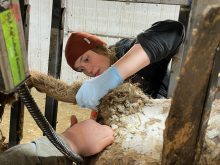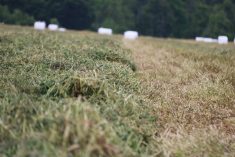SASKATOON — A viral video calling for lame horses has meant that two University of Saskatchewan vets will be busy.
The Western College of Veterinary Medicine video requesting equine participants for its caudal heel pain study drew more than 40,000 views.
Researchers Dr. Kate Robinson and Dr. Angela MacKay were surprised by the response and now have more research patients than required.
“Our summer student, Rebecca McOnie, spearheaded a two-minute video that was posted to Facebook and it went a little bit wild,” said Robinson.
Read Also

Foot-and-mouth disease planning must account for wildlife
Our country’s classification as FMD-free by the World Organization for Animal Health has significant and important implications for accessing foreign markets.
Two hundred interested clients subsequently inquired about the 32 spots available in the study.
The Saskatoon veterinarians, who are investigating how shock wave therapy affects caudal heel pain in horses, are now in the process of narrowing down the large pool of candidates.
The equine specialists will be using an MRI screen to analyze how extracorporeal shock wave therapy affects the soft-tissue surrounding the coffin and pastern joints in the forelimbs of lame horses.
Also known as navicular syndrome, caudal heel pain causes one-third of all chronic forelimb lameness in Canadian horses.
Shock wave therapy over the past decade has been found to im-prove the condition, but Robinson said there has never been a study on how the soft tissue is affected.
“Can we show that it (shock wave therapy) does help horses, and it has been used enough by clinicians to show that to be true, but we also want to know more about what it’s doing at the tissue level,” said Robinson, whose own horse suffers from caudal heel pain.
The study was prompted when the veterinarians reviewed research by Dr. Scott McClure of Iowa State University that showed horses felt better and were less lame following shock wave therapy.
The U of S veterinarians want to repeat the results of that study and then take the next step by finding clinical evidence to account for the improvement.
“Our working hypothesis is that we’ll show that shock wave therapy improves lameness in horses with caudal heel pain and also improves with lesions identified on an MRI,” said Robinson.
Garth and Pauline Long-Wright, who have a six-year-old gelding in the study, hope the registered paint can be treated for its forelimb pain, which is so severe that it has not been ridden in the past two years.
“We had never given up on a horse before, but we were at the point where we just didn’t know what to do anymore,” said Garth.
The couple had tried traditional forms of treatment such as stall rest, corrective farrier work and shoeing.
The couple hopes the U of S study will provide the gelding with enough pain relief to allow it to be ridden again and will answer questions about how to prevent future forelimb problems.
The initial phases of client screening have been completed, and base line MRIs have been performed on 23 horses . Veterinarians are not looking for more study participants.
The veterinarians are not seeking a complete cure for caudal heel pain. Instead, they are hoping that shock wave therapy will be one treatment option to go along with others.
The treatment involves sedating horses slightly so they stand and are not frightened by the loud clicking emitted by the shock wave wand when applied to the skin.
The non-invasive shock wave machine generates high-intensity pressure waves that pulse to a specific site within the injured tissue. The actual mode of action is still in dispute, but it is thought to stimulate and accelerate the healing process and provide an immediate analgesic effect with a reduction in inflammation.
Robinson and MacKay hope the research project can be expanded in the future.
“We’re not looking for more horses right now, but we are in the process of getting more funds,” said MacKay.
The origins of shock wave therapy
- The technology that uses acoustic shock waves has been used for nearly 25 years to break up kidney stones without surgery. Scientists began to consider that shock waves may also be used to heal other sorts of musculoskeletal conditions.















